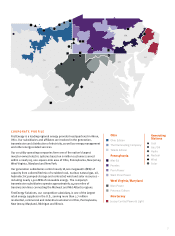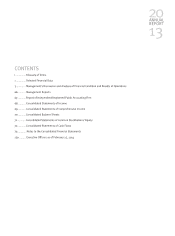Allegheny Power 2013 Annual Report Download - page 18
Download and view the complete annual report
Please find page 18 of the 2013 Allegheny Power annual report below. You can navigate through the pages in the report by either clicking on the pages listed below, or by using the keyword search tool below to find specific information within the annual report.3
FIRSTENERGY CORP.
MANAGEMENT’S DISCUSSION AND ANALYSIS OF
FINANCIAL CONDITION AND RESULTS OF OPERATIONS
Forward-Looking Statements: This Form 10-K includes forward-looking statements based on information currently available to
management. Such statements are subject to certain risks and uncertainties. These statements include declarations regarding
management's intents, beliefs and current expectations. These statements typically contain, but are not limited to, the terms
“anticipate,” “potential,” “expect,” "will," "intend," “believe,” “estimate” and similar words. Forward-looking statements involve
estimates, assumptions, known and unknown risks, uncertainties and other factors that may cause actual results, performance or
achievements to be materially different from any future results, performance or achievements expressed or implied by such forward-
looking statements.
Actual results may differ materially due to:
• The speed and nature of increased competition in the electric utility industry, in general, and the retail sales market in
particular.
• The ability to experience growth in the Regulated Distribution and Regulated Transmission segments and to continue to
successfully implement our direct retail sales strategy in the Competitive Energy Services segment.
• The accomplishment of our regulatory and operational goals in connection with our transmission plan and planned
distribution rate cases and the effectiveness of our repositioning strategy.
• The impact of the regulatory process on the pending matters before FERC and in the various states in which we do business
including, but not limited to, matters related to rates and pending rate cases or the WVCAG's pending appeal of the
Generation Resource Transaction.
• The uncertainties of various cost recovery and cost allocation issues resulting from ATSI's realignment into PJM.
• Economic or weather conditions affecting future sales and margins such as the polar vortex or other significant weather
events.
• Regulatory outcomes associated with storm restoration, including but not limited to, Hurricane Sandy, Hurricane Irene and
the October snowstorm of 2011.
• Changing energy, capacity and commodity market prices including, but not limited to, coal, natural gas and oil, and
availability and their impact on retail margins.
• The continued ability of our regulated utilities to recover their costs.
• Costs being higher than anticipated and the success of our policies to control costs and to mitigate low energy, capacity
and market prices.
• Other legislative and regulatory changes, and revised environmental requirements, including possible GHG emission,
water discharge, water intake and coal combustion residual regulations, the potential impacts of CSAPR, CAIR, and/or
any laws, rules or regulations that ultimately replace CAIR, and the effects of the EPA's MATS rules including our estimated
costs of compliance.
• The uncertainty of the timing and amounts of the capital expenditures that may arise in connection with any litigation,
including NSR litigation or potential regulatory initiatives or rulemakings (including that such expenditures could result in
our decision to deactivate or idle certain generating units).
• The uncertainties associated with the deactivation of certain older regulated and competitive fossil units including the
impact on vendor commitments, and the timing thereof as they relate to, among other things, RMR arrangements and the
reliability of the transmission grid.
• Adverse regulatory or legal decisions and outcomes with respect to our nuclear operations (including, but not limited to
the revocation or non-renewal of necessary licenses, approvals or operating permits by the NRC or as a result of the
incident at Japan's Fukushima Daiichi Nuclear Plant).
• Issues arising from the indications of cracking in the shield building and the steam generator replacement at Davis-Besse.
• The impact of future changes to the operational status or availability of our generating units.
• The risks and uncertainties associated with litigation, arbitration, mediation and like proceedings, including, but not limited
to, any such proceedings related to vendor commitments.
• Replacement power costs being higher than anticipated or not fully hedged.
• The ability to comply with applicable state and federal reliability standards and energy efficiency and peak demand reduction
mandates.
• Changes in customers' demand for power, including but not limited to, changes resulting from the implementation of state
and federal energy efficiency and peak demand reduction mandates.
• The ability to accomplish or realize anticipated benefits from strategic and financial goals including, but not limited to, the
ability to reduce costs and to successfully complete our announced financial plans designed to improve our credit metrics
and strengthen our balance sheet, including but not limited to, the benefits from our announced dividend reduction and
our proposed capital raising and debt reduction initiatives.
• Our ability to improve electric commodity margins and the impact of, among other factors, the increased cost of fuel and
fuel transportation on such margins.
• Changing market conditions that could affect the measurement of certain liabilities and the value of assets held in our
NDTs, pension trusts and other trust funds, and cause us and our subsidiaries to make additional contributions sooner, or
in amounts that are larger than currently anticipated.
• The impact of changes to material accounting policies.
























